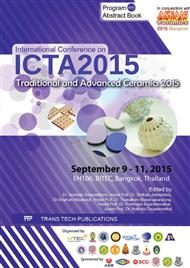p.240
p.246
p.252
p.259
p.264
p.268
p.272
p.276
p.282
Modified Composition of Low Temperature Sintering Alumina Crucible for Glass Melting
Abstract:
The low temperature sintering alumina crucible were prepared with four different formulas by modified the original formula with sintering aids CaCO3, MgCO3, Ball clay and ZrO2. The admixtures were mixed and grinded by ball mill for 24 hrs. The slurry alumina was casted in plaster mold for test samples and crucibles. After dried, the alumina was sintered at 1450, 1500 and 1550°C for 2 hrs. The sintering crucible was investigated chemical composition and properties. The crucibles were tested by melting glass at 1500°C. As a result, the composition (% by weight) was 85-94% Al2O3 2-3% SiO2 1.7-6.5% ZrO2 1.4-3.5% CaO and 0.3-1% MgO with the phase of aluminum oxide (Al2O3), spinel (MgAl2O4) and baddeleyite (ZrO2). The alumina crucible sintered at 1550°C have 9-12 % firing shrinkage density 3.35-3.64 g/cm3 and the coefficient of thermal expansion at 7.72-8.17 ´ 10-6 K-1 which depended on the composition that was similar to commercial 94% alumina (sintered at 1700°C). After tested for the melting glass, these crucibles had high thermal shock resistance which could move out of furnace without any cracks. The selected formula could be used for crucible production with lower sintering temperature, even it decreased sintering temperature from 1700°C to 1550°C. This would save 15-20% of the energy consumption.
Info:
Periodical:
Pages:
264-267
Citation:
Online since:
May 2016
Keywords:
Price:
Сopyright:
© 2016 Trans Tech Publications Ltd. All Rights Reserved
Share:
Citation:


